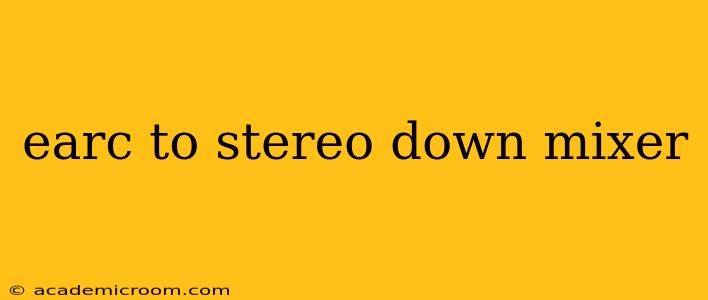The world of audio is vast and complex, particularly when dealing with multi-channel formats like Dolby Atmos or Auro-3D. These immersive sound experiences often require specialized equipment to translate them into more conventional stereo setups. This is where the Earc (enhanced audio return channel) to stereo down mixer comes in. But what exactly is it, and how does it work? This comprehensive guide delves into the intricacies of these devices, answering key questions and providing valuable insights for audio enthusiasts.
What is an eARC to Stereo Down Mixer?
An eARC to stereo down mixer is a device that takes a multi-channel audio signal from an eARC-enabled source (like a soundbar or AV receiver) and converts it into a standard two-channel (stereo) output. This is crucial for situations where your audio system doesn't support the higher-channel counts of modern surround sound formats, or if you simply prefer a simpler stereo listening experience. Think of it as a translator, bridging the gap between advanced audio technologies and older or simpler stereo equipment.
Many modern TVs and soundbars boast eARC capabilities, capable of transmitting high-bandwidth audio data like Dolby Atmos or DTS:X. However, if your amplifier or speakers are not equipped to handle these formats, the audio signal needs to be downmixed. This is where a dedicated eARC to stereo down mixer proves invaluable.
How Does an eARC to Stereo Down Mixer Work?
The process is relatively straightforward. The eARC input receives the multi-channel audio stream. The down mixer then employs various algorithms to intelligently combine the various channels into a cohesive stereo signal. These algorithms aim to preserve as much of the original soundstage and detail as possible, though some information loss is inevitable.
Different down mixing techniques exist, with some focusing on preserving dialog clarity, others prioritizing the sense of surround sound, and others aiming for a balanced approach. The specifics of the algorithm used will greatly affect the final sound quality.
What are the Benefits of Using an eARC to Stereo Down Mixer?
Using an eARC to stereo down mixer offers several advantages:
- Compatibility: It allows you to enjoy audio from modern eARC-enabled devices with older stereo systems, expanding the usability of your equipment.
- Simplicity: It streamlines the audio setup, eliminating the complexity of configuring multi-channel systems.
- Cost-effectiveness: It's a more affordable option than upgrading your entire audio setup to support multi-channel audio.
- Improved Sound Quality (potentially): A well-designed down mixer can significantly improve the stereo reproduction of multi-channel sources, providing a better listening experience than some built-in downmixing solutions.
What are the Different Types of eARC to Stereo Down Mixers?
While there isn't a distinct categorization of eARC to stereo down mixers like there is for amplifiers or receivers, the functionality can be integrated into different devices:
- Dedicated Down Mixers: These are standalone units specifically designed for down mixing eARC signals. These units often feature additional features, like volume control and other audio processing options.
- Integrated into Receivers or Soundbars: Some AV receivers or soundbars include down mixing as a built-in feature, allowing for flexibility in output.
- Software-Based Down Mixers: There are software solutions available that could theoretically achieve this functionality, although the integration with the eARC input might be challenging.
What is the difference between eARC and ARC?
eARC (enhanced Audio Return Channel) is an improved version of ARC (Audio Return Channel). The key difference lies in the bandwidth. eARC supports higher bandwidth audio formats like Dolby Atmos and DTS:X, while ARC is limited to lower bandwidth formats. Therefore, an eARC to stereo down mixer is necessary to handle the richer audio information transmitted via eARC.
Are there any downsides to using an eARC to Stereo Down Mixer?
While generally beneficial, there are some potential drawbacks:
- Information Loss: Some detail and spatial information will inevitably be lost during the downmixing process.
- Cost: While generally a more affordable option than upgrading the entire system, a dedicated down mixer still represents an additional cost.
Choosing the Right eARC to Stereo Down Mixer
The selection of the perfect eARC to stereo down mixer will hinge on your specific needs and budget. Consider the quality of the downmixing algorithm, additional features (like volume control or EQ), and compatibility with your existing equipment before purchasing.
By carefully weighing these factors, you can find the best solution to enjoy your high-quality multi-channel audio in a simpler, yet still enjoyable, stereo configuration.
